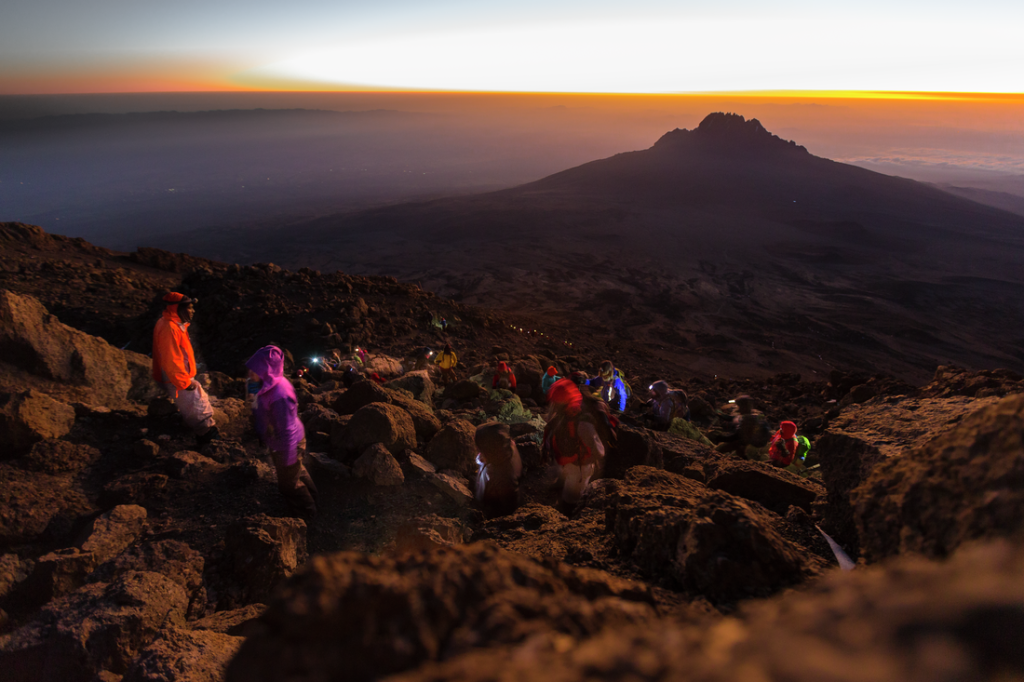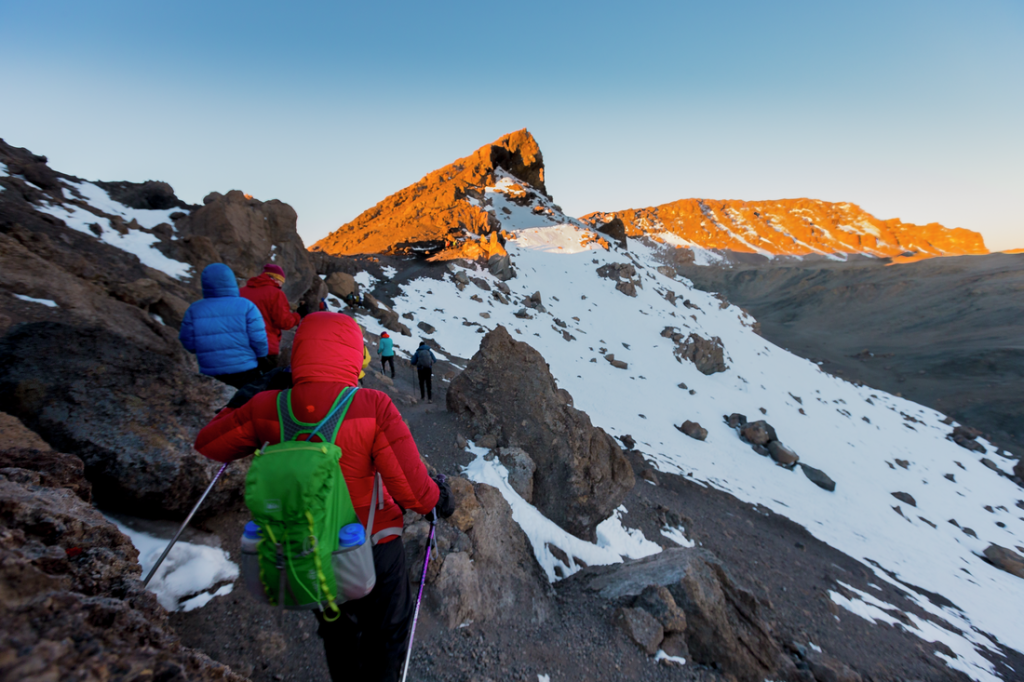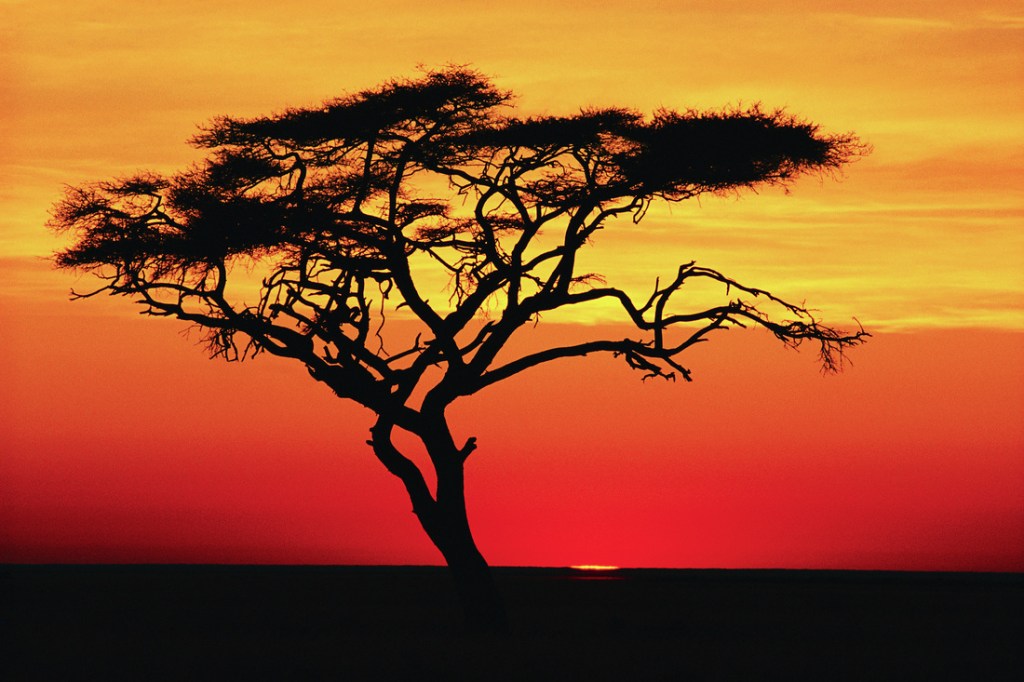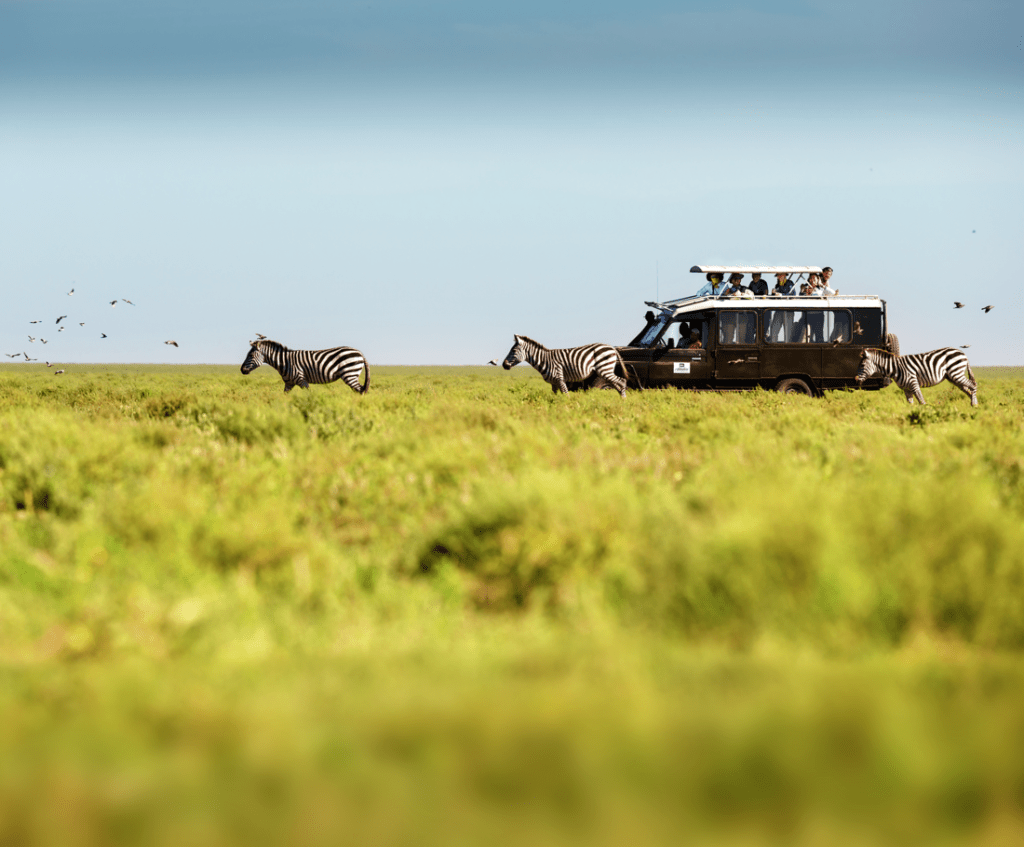Summiting Kilimanjaro is a feat topping the bucket list of the bold—to reach the lofty Uhuru Peak is to stand atop the highest mountain in Africa. Accessible from routes starting in both Kenya and Tanzania, this emblematic peak—located entirely within Tanzania’s northeastern savanna—is one of the region’s most iconic natural wonders. It’s complemented by equally impressive marvels that span both countries, from the vast, cross-country Mara-Serengeti ecosystem, where the great migration of wildebeest and zebra swarm through the savanna, to the offshore islands of Zanzibar and the Lamu Archipelago, marine utopias known for biodiversity and teeming coral reefs.
Beginning at the gates of Kilimanjaro National Park, thousands of climbers attempt to reach the summit each year. From conditioning months before you leave to experiencing more natural wonders nearby, you’ll need to do some planning to ensure you’re at your best for the climb.
If you’re just starting to explore the idea of traveling to this fascinating destination, this article will cover:

A group of hikers on a trip to Kilimanjaro make an early morning summit push.
Why You Should Climb Kilimanjaro
Towering above the African bushlands of Tanzania and Kenya, summiting Kilimanjaro is sure to be the adventure of a lifetime. Of the mountain’s three volcanic cones—Kibo, Mawenzi and Shira—it’s Kibo that harbors the highest point in Africa, extending into the sky until its end at Uhuru Peak, the summit of Kilimanjaro, standing at 19,340 feet (5,895 meters).
Following the first expedition to Kilimanjaro by Europeans Hans Meyer and Ludwig Purtscheller in 1889, the mountain has become a major climbing destination for adventurers worldwide, prompting its protected designation in 1973 within the bounds of Kilimanjaro National Park.
The Challenge of Climbing Kilimanjaro
There’s no way around it—hiking Kilimanjaro is tough. Though a strenuous experience for most, the great challenge of reaching Uhuru Peak is non-technical, meaning no technical mountaineering experience or special equipment are needed. Though you’ll be walking uphill from the start of the climb, the first few days on the trail are fairly relaxed, covering a variety of rocky, varied terrain at a slow pace, which porters call “pole-pole.” Each day requires around three to eight hours of hiking, aside from the summit day, which will have you up and on your feet for more than 16 hours. Most climbs are porter-supported, allowing participants to devote their full energy to reaching the summit.
Kilimanjaro’s Ecological Zones
Kilimanjaro National Park is so vast, it’s five distinct climate zones make the journey feel like you’re traveling from the equator to the North Pole. No matter what route you choose, you’ll pass through these ecological climates until you reach the summit at Uhuru Peak.
Bushland Zone
Altitude: 2,600 to 6,000 feet
The areas situated on the open grasslands surrounding Kilimanjaro typically receive copious rainfall. Glacial streams weave through towns like Arusha, Moshi and Marangu, making most of these mountain towns cold and misty. Many of Kilimanjaro’s guides and porters live in these areas, where enterprise entails coffee and banana cultivation.
Rainforest Zone
Altitude: 6,000 to 9,200 feet
Warm, humid and lush, every Kilimanjaro climb begins in the park’s tropical rainforest zone. This biodiverse section of the mountain is home to wildlife encounters, including sightings of Blue and Colobus monkeys and even the rare opportunity to see leopards, elephants, rhinoceroses, giraffes and buffalo near thinner patches of jungle. The trails on the south and east offer thick vegetation, as this area tends to receive more rainfall, while climbs beginning in the north near the Kenyan border are often much drier, making it more likely to see large game. If you encounter rain during your climb, it will likely be in this section.
Heath and Moorland Zone
Altitude: 9,200 to 13,200 feet
Sparser and drier than the rainforest, this low-alpine zone is home to an arid desert environment. Rife with trees draped in bearded lichen, when the rainforest zone ends and the heath and moorland zone begins, climbers ascend above the cloud line to an area where you’re likely to see your first views of Kilimanjaro’s snowy peak. Although it’s unlikely, larger animals like cape buffaloes and elephants have been known to appear in this zone, but it’s more probable you’ll see the area’s abundant bird species, including bearded vultures, augur buzzards and crowned eagles.

The upper elevations of Kilimanjaro can dip down to frigid temps, so be sure to pack warm layers.
Alpine Desert Zone
Altitude: 13,200 to 16,500 feet
The rocky zone offers windswept vistas some compare to the surface of the moon. In this area of the climb, many people begin feeling their first inklings of altitude sickness. With intense heat and solar radiation by day and plummeting temperatures that dip well below freezing at night, it’s here where the slopes of Kibo and Kilimanjaro’s summit are within reach. Most climbers spend a few hours here before starting a midnight ascent up the Kibo cone.
Arctic Zone
Altitude: 16,500 feet and above
Entering the Kibo cone, Kilimanjaro’s terrain transforms into a land of loose scree that can be quite tough to traverse. Most summit pursuits to Uhuru Peak begin in the evening when dew settles on the ground, creating a more stable surface to climb. Beyond the arctic zone’s lower sections, the landscape becomes a frozen world marked by ice and snow. Upon reaching the summit—the roof of Africa—large ice fields, glittering glaciers and the upper regions of neighboring Mawenzi cone are visible from the top.
How to Visit Kilimanjaro
Getting There
Most climbs begin in Tanzanian base towns like Moshi, Marangu and Arusha. Travelers typically arrive by way of a nonstop flight to Arusha, which is accessible from regional international capitals like Nairobi and Dar es Salaam. Car transfers can be made in advance from Arusha to Moshi and Marangu.
Why You Need to Go Guided
Trekking Kilimanjaro without a guide is prohibited by Tanzanian law. Aside from the physical endurance required to reach the summit, altitude sickness and below-freezing temperatures make a guide essential. Plus, you’ll need camping gear and food for at least five nights, as almost every route on the mountain has little to no tourist infrastructure (aside from the Marangu route’s A-frame wooden huts). Group travel is the easiest and most affordable path to the summit. For extra privacy, you can travel relatively solo, but you must hire the expertise of a guide and at least two porters for the journey. For the best experience, look for top-notch operators who cater all meals on the mountain and offer porter assistance to carry your overnight bag. Though quick ascents are offered for climbers more comfortable in high altitude, longer climbs with built-in acclimatization days are best for a range of hikers, from novice to intermediate. For shorter routes, expect to pay around $2,000 USD for a full package, while longer climbs can cost up to $6,000 USD.

A rising sun paints the sky bloodred over the plains of the Serengeti.
Routes Up Kilimanjaro
Gaining the summit of Kilimanjaro is no easy feat. While there are a number of more obscure and technical routes to the top, if you’re a casual mountaineer, hiker or traveler, it’s recommended to tackle either the Marangu, Rongai or Lemosho.
Marangu Route
Miles: 48.2 Round Trip
Elevation Gain: 13,340 feet
Typical Length of Trip: 5-10 Days Total
The only climb up Mount Kilimanjaro to offer accommodation, the hut-to-hut Marangu route is of the shortest paths to the peak and among the most comfortable. This six-day climb begins at the Marangu gate and each evening, climbers stay in picturesque A-frame huts with incredible views of Kilimanjaro National Park’s most rugged scenery. This hike is best for those who need a quicker way to the top and have more experience in high-altitude zones. Departing Kibo Hut in the middle of the night, hikers usually reach the summit in time for sunrise over Uhuru Peak.
Rongai Route
Miles: 45 Round Trip
Elevation Gain: 12,940 feet
Typical Length of Trip: 5-10 Days Total
Of all the trails to Kilimanjaro’s peak, the Rongai route is the only path approaching Kilimanjaro from the north. Beginning near the Kenyan border, this seven-day climb is often regarded as the quieter, wilder path to the summit. Eventually merging with the Marangu route for the final summit night at Kibu hut, Rongai has a more gradual slope than the mountain’s other routes and is recommended for climbers with less backpacking experience. Also making an alpine start from Kibo Hut, hikers reach the summit in the same timeframe as those hiking on the Marangu route—just as sunrise makes its way above the horizon and Uhuru Peak’s snowy saddle turns to gold.
Lemosho Route
Miles: 47.5 Round Trip
Elevation Gain: 12,340 feet
Typical Length of Trip: 7-11 Days Total
The Lemosho route offers one of the longest paths to the top of Kilimanjaro, allowing ample time for acclimatization. Typically taking eight days to summit, this route begins on the western side of the mountain and is one of the least traveled paths to the top. Access begins in Moshi or Arusha, requiring a check in at the Londorossi Gate. Beginning in a lush rainforest then weaving through juniper and pine trees, climbers reach the Shira Plateau and the gateway to the 300-foot Lava Tower, a picturesque volcanic rock formation and one of the highlights of the route. After traversing Shira Plateau and the Southern Circuit, a nocturnal wake-up call at Kosovo basecamp is the precursor to the final, seven-hour ascent to Uhuru Peak.
Planning Your Trip
Best Time to Visit Kilimanjaro
Kilimanjaro’s prime location near the equator makes it an ideal location to hike nearly year-round. But even with a temperate climate, there are a few rainy seasons to avoid, mainly from March to May and November to December. During this time, the trail conditions tend to be slippery, but doable.
How to Prepare for Your Kilimanjaro Bid
Getting in Shape: Let’s face it—it’s imperative to be physically fit to climb Kilimanjaro. To prepare for the journey, spend at least a few months leading up to your adventure doing cardio training like walking and running hills and biking long distances on high resistance to condition your body for the journey ahead.
Altitude Acclimation: Ask your doctor about any medications that may assist with your climb and increase ease of altitude acclimatization on the mountain, fending off unwanted symptoms like nausea and headaches. Most tours build in extra days to acclimatize but if you’re new to altitude, selecting a longer climb will only increase your body’s ability to successfully adjust to high-altitude conditions.
What to Pack
The trail’s many ecological zones harbor variable weather conditions, from tropical showers to piercing winds, making plenty of layers essential. Prior to packing for your trip, remember that Tanzanian law dictates that your porter is only allowed to carry 32 pounds of your gear—so, at most, a daypack and an overnight bag are recommended (if you’re on a lengthier trip and have large hard-shell luggage, you can store it in your base town hotel).
Be sure to carry your trail essentials in your daypack, as your porter will haul your overnight bag to the next campsite or mountain hut for you, which, again, is required to weigh less than 32-pounds. Because the weather in Kilimanjaro National Park can change quickly, be sure to bring a waterproof pack or a pack with a raincover with built-in hydration technology for easy access on the colder, tougher climbs. Though your guide will likely brief you on all the clothing items you need to pack, final summit temperatures are known to dip below 13 degrees Fahrenheit, so warm layers are advised.
Other Top Sites
With an abundance of natural wonders, extending your trip in Kenya and Tanzania offers incredible safari and tropical island experiences. From witnessing the great migration in the Mara-Serengeti ecosystem to island hopping through the region’s stunning archipelagos, here’s your guide for top-notch adventures in the region.

Zebra run past a group of travelers on a safari.
Top 5 Things to Do in Tanzania
Serengeti National Park: A trip to Serengeti National Park puts you in the heartland of the great migration when 1.5 million wildebeests and 200,000 zebras leave their southern breeding grounds to chase the rain on a 1,200-mile journey throughout the region’s plains and woodlands. Encompassing a 5,700-square-mile wilderness, this Big Five park is home to lion, elephant, rhino, leopard and buffalo, too.
Ngorongoro Conservation Area: This protected area in northern Tanzania is home to one of the country’s natural gems—an extinct volcanic crater spanning more than 12 miles across and nearly 2,000 feet deep. Formed after the volcano’s explosion and collapse nearly three million years ago, plentiful grassland, acacia woodland and swampy water sources are found within the formation’s amphitheater. Predators like hyenas, lions and jackals hunt small antelope species like bushbucks while elephant, hippos and the critically endangered black rhino graze the flora.
Tarangire National Park: With one of the highest wildlife populations in Tanzania, Tarangire National Park only comes second to its neighbor, Serengeti National Park, when it comes to game viewing. Though largely overlooked thanks to the area’s immensely popular attractions, this park is worth a visit to see its towering baobabs and elephant population.
Zanzibar Archipelago: The white-sand beaches and translucent waters of the Zanzibar Archipelago are sure to impress surfers and beach loungers alike. Formed by Unguja, Pemba, Mnemba and Latham Islands, the area is anchored by Stone Town, a city in Unguja. A crossroads for Africa and Arabia, beyond the historic center’s ancient buildings is a several-island oasis with seabirds and plenty of small islets to kayak and explore.
Mafia Island: Neighboring Mafia Island is set near the Zanzibar Archipelago, but it’s technically governed by mainland Tanzania. Mafia Island Marine Park sits within the island’s bounds, where divers and snorkelers come to swim among abundant populations of whale sharks and sea turtles and a coral reef ecosystem.
Top 5 Things to Do in Kenya
Maasai Mara National Reserve: A preserved savanna wilderness in southwestern Kenya, Maasai Mara National Reserve is set along the Tanzanian border, just beyond the Serengeti ecosystem. The 600-square-mile wilderness is home to lions, cheetahs, elephants, zebra, hippos and more. Additionally, the expansive area welcomes the region’s wildebeest population, where each fall, the stampede makes its U-shaped migration.
Ol Pejeta Conservancy: Kenya’s Ol Pejeta Conservancy harbors one of the rarest wildlife encounters on Earth. During a visit to the 90,000-acre, not-for-profit wildlife conservancy in Laikipia County, meet the world’s only remaining northern white rhinos, mother-daughter duo Najin and Fatu. In an area where lions, cheetahs, elephants and giraffes roam free, the conservancy is also a haven for animals like Baraka, a blind black rhino who lives safely within a 100-acre enclosure.
Samburu County: Covering a vast 8,000-square-mile expanse in northern Kenya, Samburu County spans from Ewaso Ng’iro River in the south near Mount Kenya to Lake Turkana in the north. Whether visiting iconic areas like Samburu National Reserve, Bisanadi National Reserve or the Mathews Range, the highlight of a journey to one of the area’s safari camps is as much about access to wildlife and nature as it is about experiences with the region’s Samburu culture, a sect of the Maasai.
Mount Kenya National Park: South of Samburu National Reserve, Mount Kenya, the second tallest mountain in Africa, falls short of Kilimanjaro by only 2,284 feet. One of the region’s most admirable peaks, explorations up Mount Kenya are often forgone for climbs to the peak of Kilimanjaro. Mount Kenya is also a designated UNESCO World Heritage site.
Lamu Archipelago: Situated off the coast of northern Kenya, the seven-island Lamu Archipelago is one of the country’s tropical getaways. Most travelers start in Lamu Town, a sequestered medieval village and the oldest living town in East Africa, before exploring other iconic locales like the ethereal seven-mile stretch of sand on Shela Beach, the glamorous resorts of Manda Island, and the mangrove-surrounded Paté Island, the largest in the archipelago.
